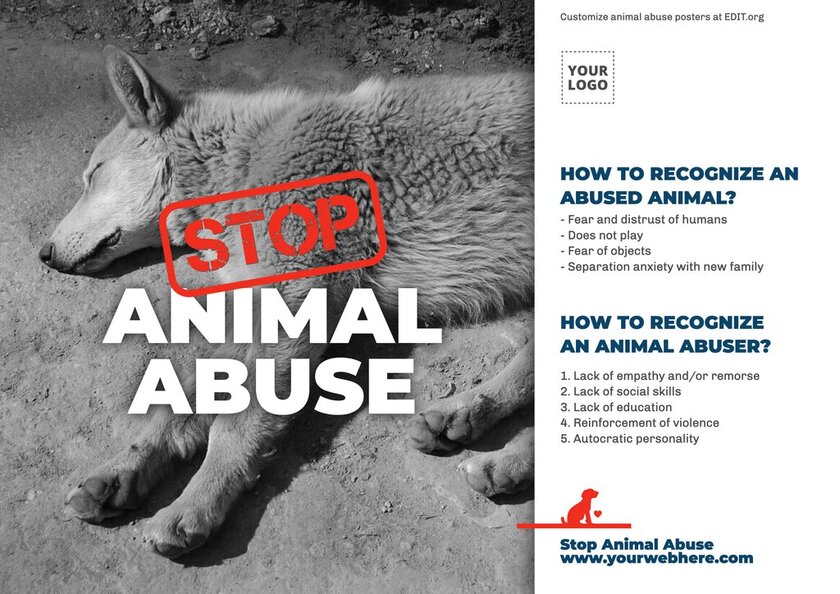Animal abuse remains an insidious blight on society, often hidden from plain sight. Yet, recognizing the signs of cruelty towards animals is an essential first step in eradicating this profound violation of rights. Understanding the indicators of abuse can empower individuals to act, thereby sparking change in both communities and beyond. This article elucidates how to spot animal abuse and offers actionable steps you can take to help.
To detect animal abuse, one must first cultivate a heightened awareness of the surrounding environment. The following indicators are critical in identifying potential cruelty:
- Physical Signs: Animals suffering from abuse may display marked physical deterioration. Look for signs such as severe injuries, untreated wounds, extreme malnourishment, or excessive lethargy. A pronounced rib cage, protruding bones, or matted fur on a pet can signal neglect or mistreatment.
- Behavioral Changes: Alterations in an animal’s behavior can provide crucial insights into its well-being. Animals subjected to abuse might exhibit anxiety, fearfulness, or aggression. In stark contrast, they may become overly submissive or defensively aggressive, hiding away from both people and familiar environments.
- Living Conditions: Observe the conditions in which the animal lives. A filthy, cramped, or otherwise hazardous environment is often indicative of neglect. Failure to provide appropriate shelter, clean water, and adequate food can serve as a flashing warning sign.
- Lack of Veterinary Care: A pet that hasn’t received regular veterinary care is at risk. Indicators include missing vaccinations, untreated illnesses, or absence of spaying/neutering, which can lead to behavioral and health issues.
- Overcrowding: Situations involving numerous animals confined to a small space can lead to severe neglect and abuse. Such environments often breed competition for resources, exacerbating the harm addressed to those involved.
Identifying these signs can engender a deep curiosity about the circumstances surrounding the animal and its owner or caretaker. Victims of cruelty often exist within the shadows of our communities. Therefore, it is not only our responsibility but our moral duty to lend attention to their plight.
Yet awareness alone is insufficient. Once you’ve discerned the signs of potential abuse, take the next pivotal step in acting responsibly. Here is a systematic approach for intervention:
- Document the Evidence: If you suspect animal abuse, observe and document everything in as much detail as possible. Use photographs, videos, and written descriptions to gather irrefutable evidence. This data can prove invaluable when reporting the situation to authorities.
- Educate Yourself: Familiarization with local animal laws and regulations is crucial. Each jurisdiction may have different definitions and legal consequences for animal cruelty. Understanding these nuances can better prepare you for reporting and advocacy efforts.
- Report to Authorities: If you firmly believe an animal is in danger, report your findings to the appropriate local authorities. This could include animal control, law enforcement, or humane societies. Providing them with your documented evidence can facilitate a more effective response.
- Engage with Local Rescue Organizations: Often, local rescue groups are attuned to the nuances of animal welfare and can provide urgent assistance. By collaborating with these organizations, you can direct resources and attention toward cases that may otherwise go unnoticed.
- Support Education and Awareness Campaigns: Advocate for community programs that educate the public about animal welfare. By supporting or even initiating campaigns that raise awareness about animal rights, you promote an environment of empathy and responsibility.
In your efforts to combat animal cruelty, consider the impact of societal attitudes towards animals. Many instances of abuse stem from deep-seated beliefs about animal worth. Shifting the perspective that animals are mere possessions, equivalent to objects, can create an environment where compassion fosters responsibility. What if we viewed animals as sentient beings deserving of respect and dignity? Such enlightenment could ignite a powerful transformation in how society perceives and treats its most vulnerable inhabitants.
Helping animals in distress also requires us to reflect on our own behaviors and choices. For instance, supporting cruelty-free products and brands can diminish the demand for industries that exploit animals. When individuals make conscious decisions about their purchases, they add pressure to businesses, encouraging more humane practices. Additionally, localization of pet sourcing helps diminish the demand for puppy mills and irresponsibly bred animals.
This issue of animal cruelty extends beyond physical mistreatment; it encapsulates emotional distress too. Engage in dialogues that address these intricacies, communicating the emotional ramifications of neglect and abuse on animals’ lives. Such discussions can inspire more collaborative undertakings aimed at reducing animal suffering.
In conclusion, becoming adept at recognizing animal abuse is merely the first step. By marrying awareness with action—documenting, reporting, engaging, and advocating—a ripple effect of empathy and awareness can be created. Consider the collective power in fostering an informed community; the ability to positively affect the lives of voiceless beings rests in our hands. Perhaps the most vital shift occurs within one’s own perspective—the understanding that we must stand as the guardians of those who cannot speak for themselves. Each act of kindness, each effort to fight against cruelty, can contribute to a larger revolution of change, ensuring that animals are treated with the dignity and respect they inherently deserve.










